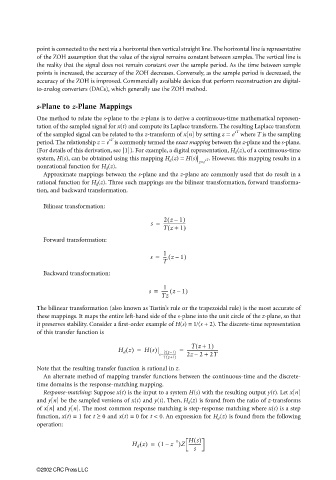Page 876 - The Mechatronics Handbook
P. 876
0066-frame-C29 Page 6 Wednesday, January 9, 2002 7:23 PM
point is connected to the next via a horizontal then vertical straight line. The horizontal line is representative
of the ZOH assumption that the value of the signal remains constant between samples. The vertical line is
the reality that the signal does not remain constant over the sample period. As the time between sample
points is increased, the accuracy of the ZOH decreases. Conversely, as the sample period is decreased, the
accuracy of the ZOH is improved. Commercially available devices that perform reconstruction are digital-
to-analog converters (DACs), which generally use the ZOH method.
s-Plane to z-Plane Mappings
One method to relate the s-plane to the z-plane is to derive a continuous-time mathematical represen-
tation of the sampled signal for x(t) and compute its Laplace transform. The resulting Laplace transform
sT
of the sampled signal can be related to the z-transform of x[n] by setting z = e where T is the sampling
sT
period. The relationship z = e is commonly termed the exact mapping between the z-plane and the s-plane.
(For details of this derivation, see [1]). For example, a digital representation, H d (z), of a continuous-time
system, H(s), can be obtained using this mapping H d (z) = H(s)| . However, this mapping results in a
z=e sT
nonrational function for H d (z).
Approximate mappings between the s-plane and the z-plane are commonly used that do result in a
rational function for H d (z). Three such mappings are the bilinear transformation, forward transforma-
tion, and backward transformation.
Bilinear transformation:
2 z 1)
(
–
s = --------------------
(
Tz + 1)
Forward transformation:
1
s = --- z 1–( )
T
Backward transformation:
1
s = ------ z 1–( )
Tz
The bilinear transformation (also known as Tustin’s rule or the trapezoidal rule) is the most accurate of
these mappings. It maps the entire left-hand side of the s-plane into the unit circle of the z-plane, so that
it preserves stability. Consider a first-order example of H(s) = 1/(s + 2). The discrete-time representation
of this transfer function is
Tz + 1)
(
H d z() = Hs()| 2 z−1) = ----------------------------
(
–
s=------------------ 2z 2 + 2T
(
Tz +1)
Note that the resulting transfer function is rational in z.
An alternate method of mapping transfer functions between the continuous-time and the discrete-
time domains is the response-matching mapping.
Response-matching: Suppose x(t) is the input to a system H(s) with the resulting output y(t). Let x[n]
and y[n] be the sampled versions of x(t) and y(t). Then, H d (z) is found from the ratio of z-transforms
of x[n] and y[n]. The most common response matching is step-response matching where x(t) is a step
function, x(t) = 1 for t ≥ 0 and x(t) = 0 for t < 0. An expression for H d (z) is found from the following
operation:
Hs()
H d z() = ( 1 z )Z -----------
−1
–
s
©2002 CRC Press LLC

